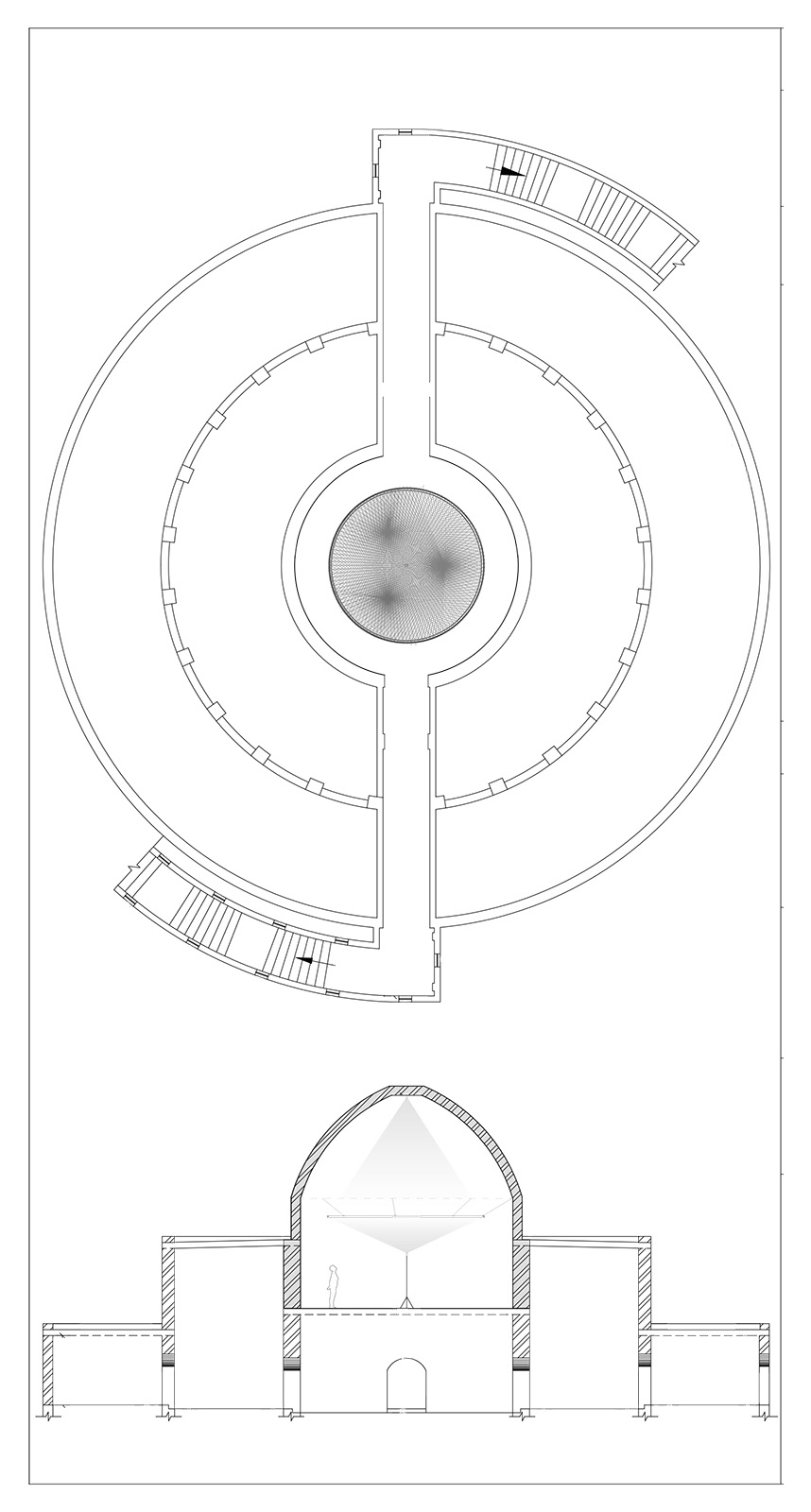In the Faraway Past and in the Future
2014. Aluminium construction, monofilament, LED lights, electric transformers, tripod. Diameter 600 cm.
Exhibition: INSERT2014, Mati Ghar, Indira Gandhi National Center for Arts, Delhi
Project development with Néstor Pérez Batista
The installation In The Faraway Past and in The Future draws from the research on Jantar Mantar, the astronomical observatories in Jaipur and New Delhi, while it is created for the dome of the building Mati Ghar. Mati Ghar was originally designed as a temporary exhibition space to house a special exhibition on time (Kala). Its design encapsulates a variety of symbolisms that are related to time, like the use of the numbers (12 [months], 24 [hours], 36 [360 parts of the year]) in the formation of the essentially circular building.
"And the work which perfectly brings together the exhibition’s thematic and affective concerns is Franke’s In the Faraway Past and in the Future (2014). Crafting an intricate galaxy on the dome of the Mati Ghar, and made entirely from something as simple as fishing lines, Franke produces a galaxy that moves and dances to the rhythm of the spectator’s careful steps as they walk looking upwards, aware that no one else is seeing what they are seeing, but also not unduly distressed by this fact. Is it the Kantian sublime that we feel as we gaze up at this fishlined galaxy? Perhaps, but unlike Kant’s starry heaven, which depends on its absolute distance to produce a sense of wonderment, Franke’s sublimity seems tantalizingly within our reach. All we need to do is take a few small steps and insert ourselves in the midst of a new adventure."[1]
[1] Liang, Lawrence. “INSERT2014”. Art Agenda. March 18, 2014. https://www.art-agenda.com/features/235670/insert2014
Photographs by: Umang Bhattacharyya, Akshat Jain. Video and photographs courtesy of INSERT2014
Plan and section of the Mati Ghar with the installation In the Faraway Past and in the Future / Mati Ghar / The geometrical division of the Jai Prakash Yantra, Jaipur / Jantar Mantar, Jaipur: Yai Prakash Jantra / Drum-shaped sandstone and plaster model of the Great Jai Prakash Yantra, Jaipur. Photo Credits Volwahsen, A., Cosmic Architecture in India
Project research notes. Edited by Shveta Sarda for the publication Insert2014
[1.1] “… Seeing that the sun has risen, his mind is filled with wonder, and with a broad smile on his face, he reflects: ‘What has happened is amazing.’” (Astronomers and their reasons: working paper on Jyotihsastra by Christopher Minkowski, Journal of Indian Philosophy, 30 (5), 495-514.)
[1.2] Jantar Mantar is an appeal to experience in the form of observations as a part of astronomical practice. A palpable experience of Earth’s cosmic motion.
[1.3] Observation of celestial bodies requires physical alignments with the instruments. The architectural scale of Jantar Mantar allows seeing ones self as being part of the movement of the universe, defining now and there, local time, and past and future.
[1.4] Astronomy is a speculative method to understand our own movement and time in relation to other bodies.
[1.5] “Placed within this complex, one is moved beyond the experience of time as a personal phenomenon, to a realization of the larger order of time in which one exists.” (On Jantar Mantar, in Kala, Exhibition in Mati Ghar, Concept: Kapila Vatsyayan, P.60)
[1.6] Jantar Mantar, Delhi, is a street laboratory of democracy. Here, protestors sing about bringing the heavens down to earth.
[1.7] Unlike observatories that use telescopes to extend our view and travel towards the stars, Jantar Mantar serves as a host to stars. Direct-sight observation makes one feel one has a very intimate connection with one’s visitors, becoming part of ‘cosmic’ movement – their and our comings and goings. It seems Jantar Mantar is a house, for stars and planets to visit us.
[1.8] The dome of the Maati Ghar employs astronomical tools in an eclectic way – disk, circles, and sphere, dividing them into degrees. It allows for observation of trajectories of apparent motion, upwards. It refracts light into the field of view of observers, making them appear as orbits of and for her own observation. It casts shadows for orientation. And yet, our brains can’t measure what they observe, but we can guess, speculate, imagine and try to find co-ordinates. [1.9] Dance of the Light Echoes
[1.9][a] A linear structure that will create light echoes, a phenomena observed in astronomy that occurs in space revealing events from distant past (light explosion).
[1.9][b] Create a sense of belonging to the abstract movement that is related to, but far away from me. A sense of being very grounded and embodied, yet part of ephemeral and vast space. It is about the wonder of observation, and of awareness that we are part of some movement caused by our interdependence.
[1.9][c] A fictional astronomical/architectural instrument in which human and her movement holds the central place, causing the observation of trajectories – orbits without center of orbiting, which may or may not be comprehensible.
[1.10] “The wheeling stars, a study of their movements, pure mathematical calculation, these shaped men’s worldview and particularly sharpened their sense of structures and systems. We are lucky to find an investigator.” From Space and the Act of Space, Kham, Exhibition in Mati Ghar








